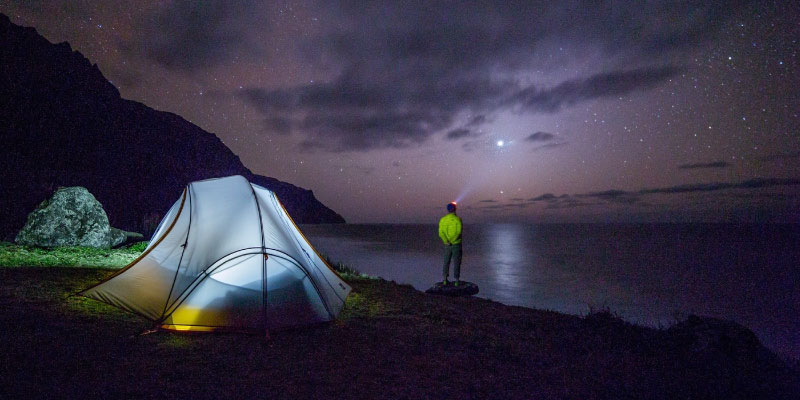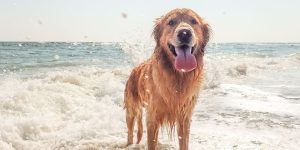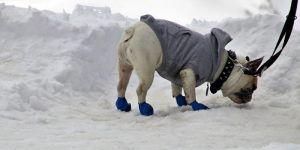If you’re looking to skip leaving the dog at home or in the kennel, why not take your pooch with you on holiday? It take a little work the first time, but once your dog is on board with the adventure, you’ve got a travel companion for life.
We all love our four-legged friends and want to take them with us wherever we go. So why should we exclude camping holidays?

It may sound like a disaster waiting to happen on paper, but there’s actually a whole community dedicated to dog camping ideas.
Your dog is part of the family, so make sure it doesn’t miss out on the fun. Try our guide to taking dogs camping to get the best out of your next holiday.
Taking dogs camping for the first time: what you need to know
From looking up dog friendly camping sites to bringing special accessories, here’s what you need to know to get started.
However, we should point out that before you even consider taking your fur friend on holiday, you need to have him well trained. He needs to have good recall and not prone to wander; if your puppy is on heat, it’s best to leave him at home.
There would be nothing more heartbreaking than losing your pup, so don’t rush into this until they are fully ready, trained and loyal to you and your family.
Consider the tent
What’s the first thing I need in terms of camping stuff for dogs? It’s super cute, but it’s true: you can get dog camping tent. This should be at the top of your dog camping essentials, particularly if yours is a large pooch.
A separate tent will give you your privacy and let you sleep better, plus you can mitigate any disasters if your dog does have a toilet incident. Speaking of which, there’s no danger of waking up the dog if you do need a visit in the middle of the night.
Can’t bear to be away from your four-legged friend? Try a tent with dog room. These are specially designed products to allow your pup to sleep beside you – your dog can even have its own sleeping quarters.
Get them used to the tent at home
If we have one tip to give you is that don’t expect to go to a camping tent with your dog and for them to just be OK with the whole idea.
A tent is a new dog bed and you have to get them use to is – whether it’s a separate dog tent or one you’ll share, you have to show them this is normal, friendly and fun.
Set up the tent at home and give them a praise and rewards if they go near it, and especially inside it. Once they are comfortable with the idea, do a test run in the garden. You need to know they will be ok dealing with the outdoor noise and comfortable in the new setting.
Finding the best dog friendly camping spot
Before you even start, you need to make sure you do your research. Most holiday providers will have a list of dog friendly sites, whether it’s for camping with dogs or just spending time in a caravan.
The good news is that most campsites will be dog friendly, even if they will ask you to keep the dog on a lead. National Parks tends to have more restrictions regarding your pooch, so Research, Research, Research.
While these sites may be happy to provide a dog bowl or advise on walking routes, don’t expect to turn up with nothing. You will need to bring your own accessories to ensure you have the best experience.
Don’t forget a good first aid dog kit
Other camping stuff for dogs includes a pet first aid kit. You can buy these prepared or make one up yourself – it’s not too dissimilar from a human first aid kit! Ensure it has a book on pet first aid.
You never know when internet signal may fail you out in the woods and you’ll need to know how to handle a twisted paw, graze or cut.
Don’t forget tick removal key. Even if your pet has anti-tick medication, they can get onboard before they realise it’s not a friendly environment. Check the bed, check the dog, and remove any intruders before going to bed.
Leash, tether and stake
You’ll also need a leash, tether and stake. As we mention before, whilst most camping site will be dog friendly, most will ask you to have your dog on a leash.
You never know when you might need to tie your dog down, so be ready to drive a stake into the earth and keep your dog safe while you wander off for a few moments. You don’t want to lock them in your car and if they get anxious in a tent, many dogs can rip right through to come and find you.
The Doggy Accessory Essentials
Everything else you need will be similar to walking the dog. Poop bags, portable water and food bowls are all absolutely essential.
If you are planning to go during cooler spring and autumn, and you have a short haired dog or one that feels the cold, blankets, jackets and jumpers may be called for. You have a sleeping bag, your dog just has his natural coat. We all need a little extra warmth sometime.
Most importantly, bring good storage food containers or bags that they can’t rip through. Take it from us, keep these safe and away from curious noses who may take advantage of easy access to have a feast. You may be out in the wild, but it’s best if you know what you’re dog’s eating.
If you are planning on going on a long hike, you’ll need most of this stuff with you anyway.
Battling the elements in Winter
Taking your dog camping is probably most fun in the warmer weather, but if you’re more hardcore, you could try winter camping with dogs. In particular, if yours isn’t a winter breed like a Husky, then don’t go camping in temperatures of less than 45°F (7°C). This could prove unpleasant for you both!
You can make the experience more fun by bringing dog boots to keep your pup’s paws warm. Also bring a reflective coat to keep warm and protect your dog from wild animals or other humans, who may mistake it for a deer.
Keep a dog brush and towel on you at all times, and make sure you have extra blankets for bedtimes. Most importantly, make sure you have access to fire – not just to keep warm, but to stop your dog’s water bowl from freezing!
Other top tips on how to camp with a dog
Camping with your dog should be a fun, rewarding and great bonding experience. For the best holiday, keep these tips in mind.
- Book a visit to your vet before you go. This will alert you to any problems like flea and tick medication. Your dog could be exposed to all sorts of bugs while you’re out in the wild.
- If you’re taking small children, make sure they don’t feed the dog anything it shouldn’t be eating. Keep a close eye on the them both, especially in the forest.
- Make sure all your paperwork is up to date. This includes microchips, ID tags, licences and details of any vaccinations. You may need to show these to the campsite owner.
- Plan your sleeping arrangements before you go. This includes how close you’ll be to the bathroom area, and whether your dog is in your tent or in its own. Don’t forget, children and other sleepers could disrupt these plans!
- If travelling in summer, never leave your dog in a hot car – even if it’s just for a few moments. Your car could reach 109°F (42°C) in as little as 10 minutes.
- When it comes to walkies, make sure you familiarise yourself with the environment before you let it off the leash. Your pup may not be accustomed to new wild animals, sights and sounds, so this could be startling.
- Finally, make sure you’re complying with the laws and etiquette of the campsite. If the area says your dog has to be kept on a leash, don’t ignore it. Likewise, don’t let your dog run around other people’s tents and caravans. You’re all here to have a good time, so be courteous.
Unlike cats, dogs are loyal to their owners wherever they go – not just their home! Embrace the changes and enjoy the dog camping holiday of your life.




